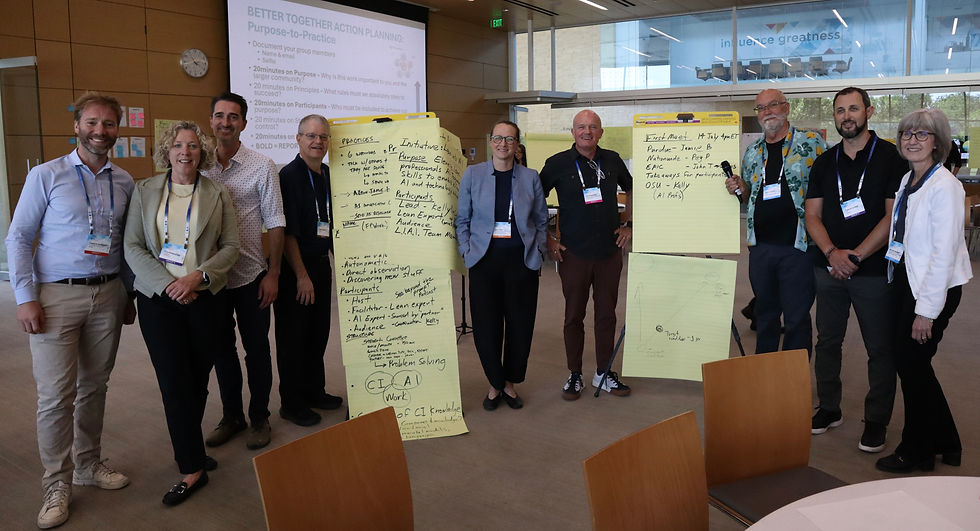Beyond Tools: The Human Side of Lean - Insights from Central Coast Lean Summit 2025
- FPW Team

- Apr 30
- 4 min read
In today's rapidly evolving workplace landscape, organizations are discovering that technical excellence alone isn't enough. The 15th Annual Central Coast Lean Summit, held in San Luis Obispo this April, brought this reality into sharp focus with its theme, "The Future of People at Work." As a gathering of lean practitioners, executives, and thought leaders, the Summit revealed a profound insight: successful organizations must master the paradox of valuing both technical processes and human dynamics.
The Neglected Half of Lean
"First we build people, then we build cars," declared Fujio Cho, former CEO of Toyota. This quote, shared by presenter Scott Gauvin, encapsulated a recurring theme throughout the Summit. While most organizations have embraced the continuous improvement pillar of lean methodology, many have neglected its equally important counterpart: respect for people.
Gauvin's session, titled "The Half of Lean We've Been Sleeping On," highlighted how organizations often prioritize tools and techniques while underinvesting in the human dimensions that make those tools effective. His framework for operationalizing respect—engaging with compassion, treating people like they matter, and partnering for mutual benefit—provided a practical approach to this challenge.
The Power of Paradox
Perhaps the most intellectually stimulating session came from John Shook and Rachel Reuter, whose combined experience spans over five decades at Toyota. They introduced the concept of paradox mindset—the ability to hold seemingly contradictory ideas simultaneously. In their view, lean organizations must be simultaneously:
Bottom-up yet top-down
Structured yet flexible
Perfection-seeking yet failure-tolerant
Their research showed that people primed with paradoxical thinking were 14% more likely to find innovative solutions to problems. "The breakthrough comes not from choosing between opposing ideas, but from embracing both simultaneously," Shook explained. This shift from "either/or" to "both/and" thinking emerged as a competitive advantage in complex environments.
Making the Invisible Visible
A consistent challenge in organizational improvement is addressing what cannot be easily seen. Colleen Soppelsa's presentation on integrating human factors into problem-solving introduced the concept of "Group Intelligence Mapping," a method for visualizing dysfunctional patterns in organizational culture.
"The most dangerous kind of waste is the waste we do not recognize," Soppelsa quoted from Shigeo Shingo, explaining how cultural and behavioral issues often remain invisible despite their significant impact. Her approach treated cultural patterns with the same analytical rigor typically reserved for technical processes.
Meanwhile, Nick Katko's session on lean accounting highlighted how financial aspects of improvement often remain invisible to operations teams. His "Box Score" tool integrated operational metrics, capacity measurements, and financial performance to create a shared language between departments.
From Burnout to Engagement
Dr. Paul DeChant's presentation on workplace burnout particularly resonated with attendees. "Burnout isn't a personal failing—it's a system problem that requires system solutions," DeChant emphasized, pointing out that individual resilience training alone is insufficient.
His three-part approach—building personal resilience, improving practice efficiency, and creating a culture of wellness—demonstrated how lean principles can directly address burnout. Particularly impactful was his case study showing burnout reduction from 50% to 12.5% through structured daily huddles that addressed the six drivers of burnout.
Leadership Transformation
Throughout the Summit, discussions repeatedly turned to the changing nature of leadership. The traditional "power over" model is giving way to a "power with" approach that values collaboration over control.
One of the highest-rated ideas from Chris Ferrier's "If we were 10 times bolder" exercise was having CEOs spend a week working in the Gemba (where the actual work happens). This reflects a growing recognition that leaders need firsthand experience of frontline challenges rather than relying solely on reports and metrics.
Technology as Enabler, Not Replacement
The Summit's final day included a focused discussion on AI implementation. The key insight was framing technology as enhancement rather than replacement. "AI should make us more human, not less," noted one participant, explaining how automation of routine tasks could create space for more meaningful human interaction.
The group emphasized the importance of education, proper framing, and demonstrating value when implementing new technologies. Their approach balanced technical considerations with human concerns—a microcosm of the Summit's broader theme.
From Insight to Action
The Summit concluded with concrete action planning using "What? So What? Now What?" frameworks. Groups developed practical approaches to operationalizing respect for people, designing effective huddles, and managing technological change. These weren't merely theoretical exercises; participants left with implementable next steps for their organizations.
Continuing the Journey
The insights from the Central Coast Lean Summit 2025 reflect a broader evolution in organizational improvement. As we navigate increasingly complex environments, the integration of technical excellence with human-centered approaches becomes not just desirable but essential.
Central Coast Lean (CCL) continues to lead this conversation through its year-round programming, including workshops, webinars, and community gatherings. If you're looking to deepen your understanding of lean principles and connect with fellow practitioners, CCL provides an invaluable regional resource. Visit their website at centralcoastlean.org to learn about upcoming events and membership opportunities.
For those interested in the broader implications of workplace transformation, the Future of People at Work (FPW) initiative offers a global community exploring these themes. As a collaboration between seven leading improvement organizations, FPW brings together diverse perspectives on how work is evolving and how organizations can thrive in changing conditions.
Join the FPW LinkedIn group to participate in monthly conversations, access resources, and connect with thought leaders in this space. Visit fpwork.org for resources, research, and community connections. The upcoming FPW Symposium on June 26-27, 2025, at OC Tanner's facility in Salt Lake City will continue exploring these themes with even greater depth.
The future of organizations doesn't lie in choosing between technical excellence and human dynamics, but in masterfully integrating both. As we navigate this paradox, communities like Central Coast Lean and the Future of People at Work provide essential guidance, resources, and connection. Whether you're a seasoned lean practitioner or just beginning your journey, these communities welcome your participation in shaping the future of work.




Comments